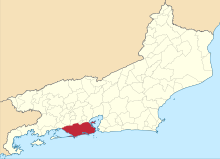Guanabara (state)
This articleneeds additional citations forverification.(January 2018) |
| State of Guanabara | |||||||||
|---|---|---|---|---|---|---|---|---|---|
| Stateof theFourth Brazilian Republic,and theMilitary dictatorship in Brazil | |||||||||
| 1960–1975 | |||||||||
 The location of the State of Guanabara, within modernState of Rio de Janeiro | |||||||||
| Capital | Rio de Janeiro | ||||||||
| Area | |||||||||
• 1975 | 1,356 km2(524 sq mi) | ||||||||
| Population | |||||||||
• 1975 | 4,858,000 | ||||||||
| Government | |||||||||
| Governor | |||||||||
• 1960 (first) | José Sette Câmara Filho | ||||||||
• 1971–1975 (last) | Chagas Freitas | ||||||||
| History | |||||||||
• Replacement of theFederal District of Brazil | 1960 | ||||||||
• Disestablished | 1975 | ||||||||
| Contained within | |||||||||
| • Country | |||||||||
| |||||||||
TheState of Guanabara(Portuguese:Estado da Guanabara,IPA:[ɡwɐnaˈbaɾɐ]) was astateofBrazilfrom 1960 to 1975, which included the city ofRio de Janeiro.It was named afterGuanabara Bayto the east of the state.[1]It was created from the territory ofthe old Federal Districtwhen the federal capital moved from Rio de Janeiro toBrasíliaanda new Federal Districtwas erected around the new capital. In 1975 the State of Guanabara was merged with the surroundingState of Rio de Janeiro,within which its territory became theMunicipalityof Rio de Janeiro.
History
[edit]In 1834, the city of Rio de Janeiro was elevated toImperial capitalof theEmpire of Brazil,and was included in theNeutral Municipality(Portuguese:Município Neutro). The surrounding Province of Rio de Janeiro (which did not include the city) had its capital city inNiterói.When Brazil became a republic in 1889, the city of Rio de Janeiro remained the national capital, and the territory of the Neutral Municipality became theFederal District(Portuguese:Distrito Federal), while the surrounding homonymous province became a state, still with Niterói as its capital.
In 1960 theFourth Brazilian Republicmoved the national capital toBrasíliaanda new Federal Districtwas created for it. The old Federal District became a state, named Guanabara.[1]
Throughout its 15-year existence, Guanabara was a unique state in many ways. Comprising only one city (albeit a large one), Guanabara was the smallest Brazilian state by land. It also had the peculiarity of being the only Brazilian state that was not divided into municipalities. There was no mayor, municipal legislature or any other municipal government institution there, as the city of Rio de Janeiro was directly administered by the state government of Guanabara. On the other hand, that also meant that the Guanabara state government had some functions that were normally assigned to municipalities elsewhere, such as regulating urbanzoning,inspecting the safety of buildings, or issuing licenses for commercial venues, for example.
All the characteristics disappeared in 1975, whenthe military dictatorshipmerged the state of Guanabara into the state ofRio de Janeiro.(Legally, the merger dissolved both Guanabara and Rio de Janeiro, creating a new state, also named Rio de Janeiro.) The capital of the reconstituted state of Rio de Janeiro was changed from Niterói back to the city of Rio de Janeiro, as had been the case until 1834.
Electoral history
[edit]In gubernatorial elections held on 3 October 1965,Francisco Negrão de Lima,a candidate supported by a coalition formed byPTBandPSDand a close associate of former PresidentJuscelino Kubitschek,won the race to be the state's governor, garnering 52% of the votes cast.[2]
References
[edit]- ^abFranco, Paulo (2014).Diversity – The Brazilian Essence: Knowing Brazil By the Culture of Their People.pp. 47–49.ISBN9781483412559.Retrieved3 January2018.
- ^Alves, Maria Helena Moreira (1985).State and Opposition in Military Brazil.The University of Texas Press.ISBN9780292761391.Retrieved3 January2018.


